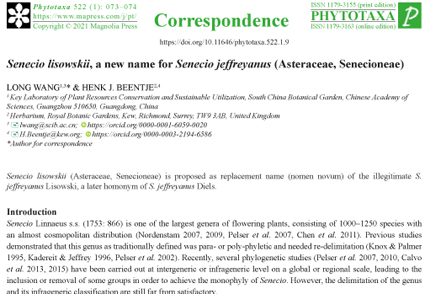Abstract
N/A
References
<p>Beentje, H.J. (in press) <em>Senecio </em>L. <em>In</em>: Timberlake, J.R. & Martins, E.S. (eds.) <em>Flora Zambesiaca</em>, vol. 6 (4). Royal Botanic Garden, Kew, London.</p>
<p>Calvo, J., Álvarez, I. & Aedo, C. (2015) Systematics of <em>Senecio </em>section <em>Crociseris </em>(Compositae, Senecioneae). <em>Phytotaxa </em>211: 1–105. https://doi.org/10.11646/phytotaxa.211.1.1</p>
<p>Calvo, J., Álvarez, I., Aedo, C. & Pelser, P.B. (2013) A phylogenetic analysis and new delimitation of <em>Senecio</em> sect. <em>Crociseris</em> (Compositae: Senecioneae), with evidence of intergeneric hybridization. <em>Taxon</em> 62: 127–140. https://doi.org/10.1002/tax.621011</p>
<p>Chen, Y.L., Nordenstam, B., Jeffrey, C. & Vincent, L. (2011) <em>Senecio</em> Linnaeus. <em>In</em>: Wu, Z.Y., Raven, P.H. & Hong, D.Y. (eds.) <em>Flora of China</em>, vol. 20–21. Science Press, Beijing & Missouri Botanical Garden Press, St. Louis, pp. 508–536.</p>
<p>Diels, F.L.E. (1912) Plantae Chinenses Forrestianae. New and imperfectly known species.<em> Notes from the Royal Botanic Garden, Edinburgh </em>5: 161–308.</p>
<p>Kadereit, J.W. & Jeffrey, C. (1996) A preliminary analysis of cpDNA variation in the tribe Senecioneae (Compositae). <em>In</em>: Hind, D.J.N & Beentje, H.J. (eds.) <em>Proceedings of the International Compositae Conference, Kew, 1994</em>, vol. 1. Royal Botanic Gardens, Kew, pp. 349–360.</p>
<p>Knox, E.B. & Palmer, J.D. (1995) The origin of <em>Dendrosenecio </em>within the Senecioneae (Asteraceae) based on plastid DNA evidence. <em>American Journal of Botany</em> 82: 1567–1573. https://doi.org/10.3732/ajb.89.6.929</p>
<p>Linnaeus, C. (1753) <em>Species Plantarum</em>. Laurentius Salvius, Holmiae, 1200 pp.</p>
<p>Lisowski, S. (1991) Les Asteraceae dans la flore d’Afrique Centrale (excl. Cichorieae, Inuleae and Vernonieae), vol. 2. <em>Fragmenta Floristica et Geobotanica</em> 36 (1) (Suppl. 1): 251–627.</p>
<p>Nordenstam, B. (2007) Tribe Senecioneae Cass. <em>In</em>: Kadereit, J.W. & Jeffrey, C. (eds.) <em>The Families and Genera of Vascular Plants</em>, vol. 8. Springer, Berlin, pp. 208–242.</p>
<p>Nordenstam, B., Pelser, P.B., Kadereit, J.W. & Watson, L.E. (2009) Senecioneae. <em>In</em>: Funk, V.A., Susanna, A., Stussey, T.F. & Bayer, R.J. (eds.) <em>Systematics, Evolution, and Biogeography of Compositae</em>. International Association for Plant Taxonomy, Vienna, pp. 503–525.</p>
<p>Pelser, P.B., Gravendeel, B. & van der Meijden, R. (2002) Tackling speciose genera: species composition and phylogenetic position of <em>Senecio </em>sect. <em>Jacobaea </em>(Asteraceae) based on plastid and nrDNA sequences. <em>American Journal of Botany</em> 89: 929–939. https://doi.org/10.3732/ajb.89.6.929</p>
<p>Pelser, P.B., Nordenstam, B., Kadereit, J.W. & Watson, L.E. (2007) An ITS phylogeny of tribe Senecioneae (Asteraceae) and a new delimitation of <em>Senecio </em>L. <em>Taxon</em> 56: 1077–1104. https://doi.org/10.2307/25065905</p>
<p>Pelser, P.B., Tepe, E.J., Kennedy, A.H. & Watson, L.E. (2010) The fate of <em>Robinsonia</em> (Asteraeae): sunk in <em>Senecio</em>, but still monophyletic? <em>Phytotaxa</em> 5: 31–46. https://doi.org/10.11646/phytotaxa.5.1.2</p>
<p>Turland, N.J., Wiersema, J.H., Barrie, F.R., Greuter, W., Hawksworth, D.L., Herendeen, P.S., Knapp, S., Kusber, W.-H., Li, D.-Z., Marhold, K., May, T.W., McNeill, J., Monro, A.M., Prado, J., Price, M.J. & Smith, G.F. (2018) International Code of Nomenclature for algae, fungi, and plants (Shenzhen Code) adopted by the Nineteenth International Botanical Congress Shenzhen, China, July 2017. <em>Regnum Vegetabile </em>159: 1–254. https://doi.org/10.12705/Code.2018</p>
<p>Calvo, J., Álvarez, I. & Aedo, C. (2015) Systematics of <em>Senecio </em>section <em>Crociseris </em>(Compositae, Senecioneae). <em>Phytotaxa </em>211: 1–105. https://doi.org/10.11646/phytotaxa.211.1.1</p>
<p>Calvo, J., Álvarez, I., Aedo, C. & Pelser, P.B. (2013) A phylogenetic analysis and new delimitation of <em>Senecio</em> sect. <em>Crociseris</em> (Compositae: Senecioneae), with evidence of intergeneric hybridization. <em>Taxon</em> 62: 127–140. https://doi.org/10.1002/tax.621011</p>
<p>Chen, Y.L., Nordenstam, B., Jeffrey, C. & Vincent, L. (2011) <em>Senecio</em> Linnaeus. <em>In</em>: Wu, Z.Y., Raven, P.H. & Hong, D.Y. (eds.) <em>Flora of China</em>, vol. 20–21. Science Press, Beijing & Missouri Botanical Garden Press, St. Louis, pp. 508–536.</p>
<p>Diels, F.L.E. (1912) Plantae Chinenses Forrestianae. New and imperfectly known species.<em> Notes from the Royal Botanic Garden, Edinburgh </em>5: 161–308.</p>
<p>Kadereit, J.W. & Jeffrey, C. (1996) A preliminary analysis of cpDNA variation in the tribe Senecioneae (Compositae). <em>In</em>: Hind, D.J.N & Beentje, H.J. (eds.) <em>Proceedings of the International Compositae Conference, Kew, 1994</em>, vol. 1. Royal Botanic Gardens, Kew, pp. 349–360.</p>
<p>Knox, E.B. & Palmer, J.D. (1995) The origin of <em>Dendrosenecio </em>within the Senecioneae (Asteraceae) based on plastid DNA evidence. <em>American Journal of Botany</em> 82: 1567–1573. https://doi.org/10.3732/ajb.89.6.929</p>
<p>Linnaeus, C. (1753) <em>Species Plantarum</em>. Laurentius Salvius, Holmiae, 1200 pp.</p>
<p>Lisowski, S. (1991) Les Asteraceae dans la flore d’Afrique Centrale (excl. Cichorieae, Inuleae and Vernonieae), vol. 2. <em>Fragmenta Floristica et Geobotanica</em> 36 (1) (Suppl. 1): 251–627.</p>
<p>Nordenstam, B. (2007) Tribe Senecioneae Cass. <em>In</em>: Kadereit, J.W. & Jeffrey, C. (eds.) <em>The Families and Genera of Vascular Plants</em>, vol. 8. Springer, Berlin, pp. 208–242.</p>
<p>Nordenstam, B., Pelser, P.B., Kadereit, J.W. & Watson, L.E. (2009) Senecioneae. <em>In</em>: Funk, V.A., Susanna, A., Stussey, T.F. & Bayer, R.J. (eds.) <em>Systematics, Evolution, and Biogeography of Compositae</em>. International Association for Plant Taxonomy, Vienna, pp. 503–525.</p>
<p>Pelser, P.B., Gravendeel, B. & van der Meijden, R. (2002) Tackling speciose genera: species composition and phylogenetic position of <em>Senecio </em>sect. <em>Jacobaea </em>(Asteraceae) based on plastid and nrDNA sequences. <em>American Journal of Botany</em> 89: 929–939. https://doi.org/10.3732/ajb.89.6.929</p>
<p>Pelser, P.B., Nordenstam, B., Kadereit, J.W. & Watson, L.E. (2007) An ITS phylogeny of tribe Senecioneae (Asteraceae) and a new delimitation of <em>Senecio </em>L. <em>Taxon</em> 56: 1077–1104. https://doi.org/10.2307/25065905</p>
<p>Pelser, P.B., Tepe, E.J., Kennedy, A.H. & Watson, L.E. (2010) The fate of <em>Robinsonia</em> (Asteraeae): sunk in <em>Senecio</em>, but still monophyletic? <em>Phytotaxa</em> 5: 31–46. https://doi.org/10.11646/phytotaxa.5.1.2</p>
<p>Turland, N.J., Wiersema, J.H., Barrie, F.R., Greuter, W., Hawksworth, D.L., Herendeen, P.S., Knapp, S., Kusber, W.-H., Li, D.-Z., Marhold, K., May, T.W., McNeill, J., Monro, A.M., Prado, J., Price, M.J. & Smith, G.F. (2018) International Code of Nomenclature for algae, fungi, and plants (Shenzhen Code) adopted by the Nineteenth International Botanical Congress Shenzhen, China, July 2017. <em>Regnum Vegetabile </em>159: 1–254. https://doi.org/10.12705/Code.2018</p>


